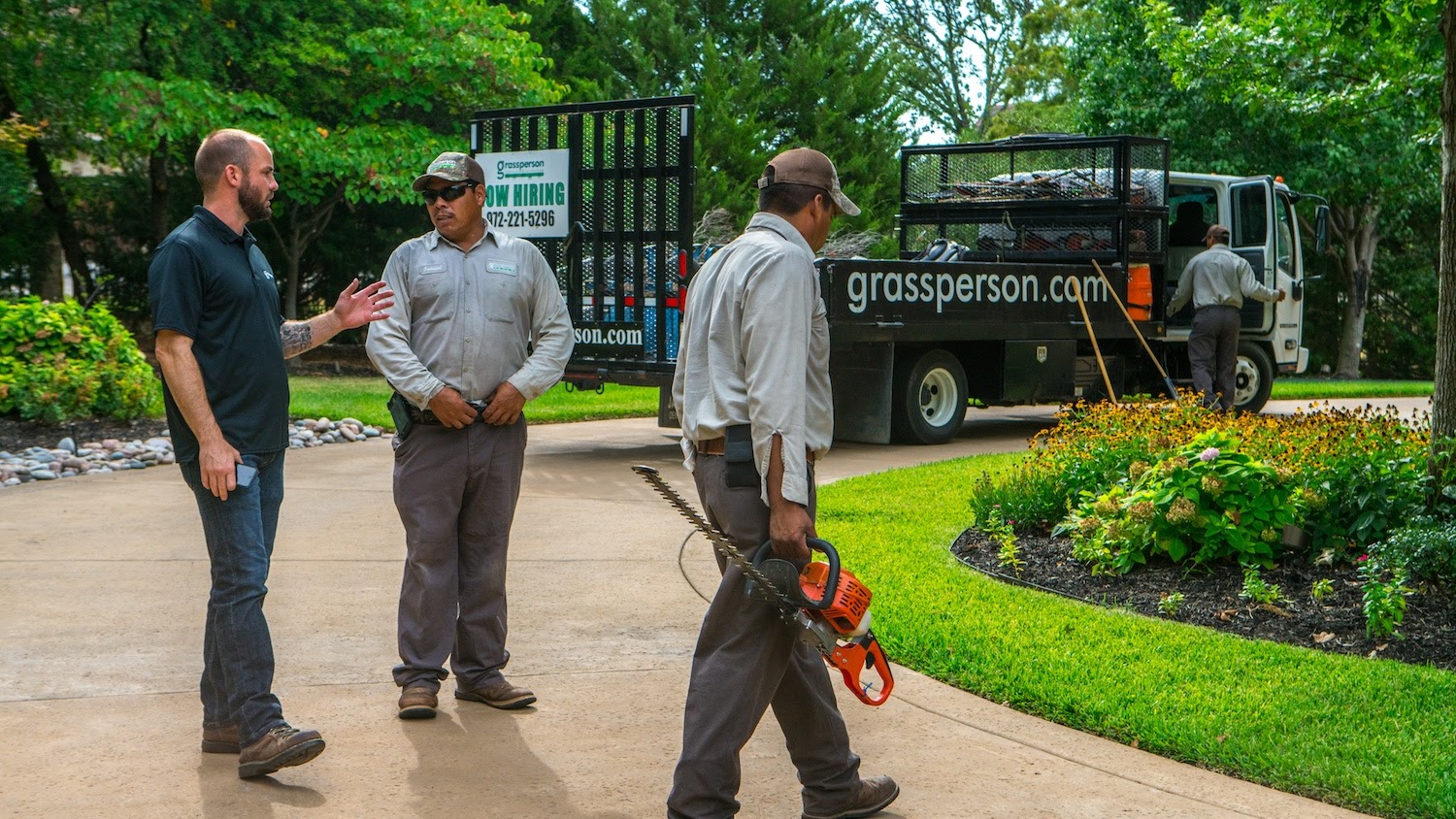Mowing the neighbors’ lawns, in particular, is something that many Americans do during their dog days of high school or college break to make a quick buck.
And if you were one of them, lawn mowing probably gave you your first taste of a paycheck or perhaps sowed the first ever seed of entrepreneurship in you.
While the job of manicuring grass has a low barrier to entry, the economics around America’s lawn care industry is no joke.
On average, you can gross about $80,000 a year in revenue by running a successful lawn care business.
But spending your summer weekends trimming grass is one thing—turning it into a profitable business is another thing altogether.
Unlike other small businesses, lawn care is a seasonal affair. You can make hay while the sun shines. But you will either have to shut shop for a few months or find a new hustle in the winter.
And since the hurdles to enter the lawn care business is pretty low, it’s also one of the most competitive small businesses out there.
Getting started with your lawn care business
As a lawn care business owner, you won’t just compete with other landscaping businesses. You will also compete with local teenagers from around the block or fly-by-night business upstarts who will undercut your business mostly in terms of price.
But the biggest roadblocks in running a lawn care business are not financial or operational—they are physical and psychological.
You need mental toughness to toil every day, the grit to get scorched in the hot summer sun for 50–60 hours every week, and a team of people who share the self-discipline to jostle alongside you for doing this kind of grunt work.
The sunny side to all of this is—you will get a naturally tanned beach bod and a generous dose of vitamin D levels from being exposed to all that sunlight.
Despite the challenges mentioned above, the overall pros of owning a lawn care business outweigh the cons.
For starters, you can start your own lawn care business either by pooling in your rainy-day savings or taking out a personal credit card loan for under $10,000.
That’s because the initial investment cost for starting a lawn care business is ridiculously low. Unlike other small business ideas, opening a lawn care business also has significantly low overhead costs.
For example, you don’t necessarily need commercial real estate to start offering your lawn care services. Your customers can contact you directly on your mobile phone number while you make do with your garage or your Ford Ranger pickup truck as your office.
Other initial costs include buying 4–5 high-performance lawn mowers, leaf blowers, garden scissors, UV-protected sunglasses for your crew members, and plenty of sunscreen.
On the earning front, the demand for the lawn care business is at an all-time high. Although grass only occupies 2% of the total land area in the mainland US, lawn grass is the most irrigated crop in the country.

[Source]
From being a $69.8 billion industry in 2013, the market for lawn care and landscaping has grown exponentially and is closing in on being a trillion-dollar industry pretty soon.
Therefore—although it’s a seasonal business—there’s always a high demand for lawn care services during peak summer seasons. That means you will never have a problem finding business as long as your neighbors’ grass blades grow tall.
Add to that the advantage of being a local business owner. Most lawn care businesses get their customers by leveraging their network in the local community and through word-of-mouth referrals.
There’s very little learning curve—like how to use the equipment, how to stripe a lawn, or how to sharpen your mower blades, whether to grass-cycle or bag the grass clippings to the nearest landfills, and so on.
Overall, owning a lawn care business is a good self-employment opportunity with lots of sunny prospects. It’s an easy business idea that will literally turn green grass to green cash.
And in case you’re worried about its seasonal life span, lawn care is a business you can easily run on the side while keeping your main source of income alive.
With the right kind of planning and preparation, lawn care is the type of business that everyone can run profitably.
You just have to develop the business acumen to effectively manage your cash flow, hire the right people, market your business to the right customers, and keep your business sustainable.
In this blog, we are going to cover the following areas to give you a thorough idea of what it takes to get your own lawn care business up and running:
- Financial considerations before getting started
- Qualifications and industry requirements
- Building a stable customer base
- Networking with others in related fields
- Managing the challenge of seasonality and regionality
Financial considerations before getting started
You have to spend money to make money. Just like opening any other small business, starting a lawn care business demands an initial upfront cost and a few recurring costs to keep it running.
Let’s look at all of them in detail.
Initial financing
You will need a startup budget to open your lawn care business. This seed money will help you with every other prerequisite that needs investment, like hiring people, buying equipment, buying insurance, and so on. We will talk about all of those points in the sections below.
Luckily for lawn care businesses, the initial investment is not that expensive. For instance, you can start your lawn care business under $10,000 with just a few tools and no staff.
Most lawn care business owners start by cashing in their income tax refunds or taking a credit card loan. You just have to fight the temptation of going big all at once and buying fancy power tools or leasing an expensive office—those costs will easily go up in thousands.
Your investment cost might be even lower if you already own a vehicle, a power lawn mower, and some gardening tools lying around in your tool shed.
If you don’t have a ready-capital to invest in opening a landscape business, considering the following options:
1. 401(k) financing: 401(k) are tax-free retirement savings that almost every working professional will have to their name. In the US, it’s the second most popular form of business financing—right after direct cash investment—for Americans to finance their new business.
If you have a 401(k) savings, you can withdraw it to fund your lawn care business startup. Other than being a debt-free option to finance your business, there are several ways you can use to avoid paying tax penalties for withdrawing your 401(k) money.
2. Small business loans: If you have a good credit score, you can opt for a small business loan to start your lawn care business.
The Small Business Administration (SBA) facilitates a wide range of services to help small business owners find a loan to fund their business idea. Here are the most common types of SBA loans:
- SBA 7(a) loans
- SBA microloans
- SBA CDC/504 loans
- SBA CAPLines of Credit
- Veterans Advantage loans
- Community Advantage loans
- Export Express & Export Working Capital Loans
The SBA doesn’t directly offer these loans. Instead, it matches borrowers with verified lenders and regulates the loan guidelines. Most of these loans have low interest rates and flexible repayment terms in contrast to the loans you might take directly from a bank.
In contrast to the loans that you might take directly from a private bank, you will have the low interest rates and long-term repayment program if you opt for the loan options from SBA.
The SBA also guarantees these loans, which means the lenders will get up to 85% of the loan money even if you default on the payment. So it’s the low-risk arrangement for both you and the lending party.
3. Unsecured loans: You can get a personal or credit card loan to fund your lawn care business, given you have an above-average credit score (690 and above).
There are some very good upsides to taking these short-term loans. First, you won’t need to risk your personal property or a collateral asset.
You can also withdraw anywhere from $10,000–$150,000 at once—depending on your credit worthiness. And if approved, the processing of the loan amount doesn’t take more than 3–4 days.
The risks involved in taking unsecured loans is that the interest rates can be pretty high. For instance, payday loans are the worst form of short-term loans that come with hidden terms and conditions and unpleasant surprises.
With many personal loans, there are also financial penalties even if you want to close your loans earlier than the stipulated loan timeline.
Asking your friends or family to lend you money is also a type of unsecured loan. You can set your own terms and formalize the agreement by signing paperwork. But this method also holds equal risks of the other forms of unsecured loans discussed above.

Other financial costs
Once you shore up enough capital to fund your lawn care business idea, you will have to invest a little bit money to legally set up your company.
- Company registration
- Licenses, permits, and other paperwork
- Hiring
- Insurance
- Equipment purchase
Let’s dive deeper to understand the financial nuances involved in getting these things done.
1. Register your lawn care business
Registering your business is the first step towards establishing the legitimacy of your company as a legal entity. At this point, you would want to think of an easy-to-remember name for your company.
Once you do that, there are four different choices for you to register your lawn care business.
Sole proprietorship
If you are or want to be the sole owner of the company, you can decide to register it as a sole proprietorship.
In most cases, you don’t even have to register your lawn care business as a sole proprietorship. That’s because if you start a business as an individual, it becomes a sole proprietorship business by default.
Therefore, there isn’t any actual cost involved in registering a sole proprietorship. However, you might want to go through a few legal formalities such as applying for a retail license, registering for a sales tax, and submitting a Doing Business As (DBA) application with your local government body.
It’s easy to register, maintain, and dissolve a sole proprietorship business in contrast to other forms of business registration. For instance, the tax file process for a sole proprietorship business is as easy as reporting your business earnings and losses in your personal income tax return.
But the downside is that if your business ever lands in a legal soup like debts, you will be held personally liable for the lawsuits. And you might even risk losing your personal property or the money in your personal bank account to repay the debt amount.
General partnership
You will need to register your lawn care business under general partnership if you have your wife, sibling, or a friend as your business partner.
In a general partnership, each of the partners involved will share the rights, liabilities, and earnings equally. If a partner wants to have more or less say in the partnership, it’s best to register the company as a limited liability company, or LLC.
The cost of incorporating a general partnership is less than that of an LCC or a corporation, but its taxation process is a little more complicated.
Corporation
If you don’t want to be personally liable for the debts or lawsuits your business might incur, you should register your company as a corporation. In the eyes of the US law, business corporations have the same “person” status as that of an individual.
The cost of filing your company as a corporation differs from one state to another. For instance, some states in the US will charge you $50 to register a corporation while some will charge you a $200 one-time registration fee.
Limited liability company (LLC)
Registering your lawn care services company as an LLC is the safest way to protect yourself from legal liabilities while saving yourself from the burden of double taxation.
You also won’t have complex requirements like record-keeping if you file your lawn care business as an LLC.
The state filing cost for registering an LLC ranges between $40–$500, depending on which state you are. You will also have to pay a yearly fee to the state government to maintain your LLC’s good standing.
2. File for other paperwork, obtain licenses and permits
Apart from registering your business, you will also need a few licenses and permits to conduct your business legally.
Keep in mind that these are not just capital costs, but regulatory requirements for your business to avoid getting mixed in unnecessary legal hassles.
Here’s a list of licenses that your lawn care business will need:
1. General business license
Getting a general business license is easy and might cost you anywhere from $15 to $200 per year.
2. Employment identification number (EIN)
If you are planning to employ people in your lawn care business, you would need to apply for an EIN. It’s free of cost to obtain an EIN if you do it on your own. If you decide to hire a legal agency to do it for you—along with a host of other tasks—they might charge you $75 or above.
3. Contractor license
US states such as North Carolina and Oregon demand landscape contractors to have a contractor license surety bond.
The fee is usually a small percentage of your bond amount. For instance, if you want a $10,000 surety bond, you might fork up between $100 to $500 as its bond premium.
Getting a contractor license is a way to hold your business accountable and to protect your customers’ interests.
4. Sales tax license
A handful of states in the US charge businesses a sales tax amount for selling retail goods or offering their professional services. The highest you might pay to get a sales tax license for your landscaping business is $50, depending on your state.
5. Other permits
You will also need to pay a few hundred bucks to get a number of permits to comply with government regulations. The cost of getting these permits varies by city, county, or state government.
For instance, you would need a sign permit from your city’s zoning department to put up your business signage.
If you have an office space that is open to the public, your business will require a fire permit.
3. Hire a team
Hiring people to help you run your lawn care business is also a financial consideration because you have to pay your staff. How much you pay your employees impacts your pricing decision, and other areas of your finances.
As of 2020, the average pay for lawn care professionals hover around $11–$14 per hour. You will have to factor that in by estimating the number of hours you would need your crew to spend on the field every day or every week, and the number of people you are willing to hire.
For instance, say you hire five people for $12 an hour (per person) to work for you 8 hours a day. If your team works five days a week, that would cost you an average of $480 per person, or $2,400 in weekly payroll.
4. Buy insurance coverage
Unlike other small businesses, you can have decent liability insurance to cover your lawn care business against injuries and damage to people or property.
The insurance policy usually covers legal costs and payouts in case you are liable for the injuries or damages.
On average, the liability insurance will cost you around $45 a month or $530 annually.
By law, you are also required to pay for workers’ compensation insurance, disability insurance, and unemployment insurance.
Again, the cost estimates for these insurances vary on many grounds such as the insurance provider, the nature of the policies, the number of employees, etc. On average, these three can add up to $7,000–$10,000 per year.
5. Purchase equipment
You would need professional, high-grade mowing and gardening equipment to start your lawn care business. Here are a few must-have tools that you would need to have:
| Tools | Estimated price per tool |
| Mower | $500 |
| Trimmer | $200 |
| Leaf blower | $200 |
| Hand tools (trimmers, edgers) | $100 |
| Gasoline can | $25 |
| Oil and gasoline | $20 per tank |
| Utility trailer | $800 |
| Spreaders and sprayers | $50 |
| Eye goggle | $10 |
| Face mask/respirator | $10/$300 |
| Hearing protector | $15 |
On average, the cost to buy all of the above items and some sophisticated landscaping tools comes around to $6,000–$10,000.
You would also need a vehicle to ferry your crew and tools to your customers’ property.
The good news is, you can lease not only the vehicle but also most of the above-mentioned tools instead of paying a hefty amount out of your pocket. Or, you can also opt for rent-to-own equipment leasing to minimize your upfront investment cost.
Leasing the necessary equipment will also save you the hassles of maintaining these equipment during the off-season.
Qualifications and industry requirements
You don’t need any technical qualifications or formal training to start a lawn care business or become a landscaping professional.
The only qualification you need is the basic knowledge to operate the lawn mower and the ability to lift heavy objects and work long hours in unfavorable weather conditions.
But while the formal training and certifications are completely optional, they are helpful in marketing your business to prospective customers and gaining their trust. For customers, hiring certified lawn care professionals means having trustworthy people looking after their property.
Below are three certifications that you might consider getting to boost your credibility as a lawn care entrepreneur.
1. Landscape Industry Certified Lawn Care Technician
The National Association of Landscape Professionals (NALP) offers a host of landscape certifications.
Out of all the courses it offers, the Landscape Industry Certified (LIC) Lawn Care Technician is one of the most sought-after trainings because of its scope of wide area of application in the lawn care industry.
The course teaches you to identify the different types of turfgrass, the best way to water plants, the best ways to fertilize and lime the soil, how to set up irrigation, and so on.

[Source]
It’s a self-paced course that you can complete without any timeline restrictions. At the end of the course, you can take an online test and get certified as an LIC Lawn Care Training if you score 70% on the exam.
There’s no course fee for the LIC Lawn Care Technician course. But you have to buy the study material on your own and pay $300 (if you are an NALP member) or $400 (if you aren’t a NALP member) to take the test. There are additional costs per section for retaking the test.
Alternatively, you can also get certified in the degree program from one of the many NALP-accredited colleges.
2. Pesticide control certification or license
A certification in pesticide applicator is great for you if you want to earn a specialization in using chemical fertilizers and government-approved pesticides.
Your local state, territorial, or tribal authority issues the pesticide applicator license. Once you are licensed, you can supervise pesticide operations or register yourself as a pest control dealer in your region.
The duration and nature of the course varies from one state to another. Some states grant you the certification once you score 70 or above on the tests. In most cases, the license lasts for 3–4 years, after which you have to pay a small fee and appear for a re-test to get yourself recertified.
A few states like Delaware might require you to have at least two-years of experience working under a certified applicator in the past three years.
3. Certified snow professional
If you are surprised to find the mention of “snow” in a list of lawn care certifications—don’t be.
Lawn care is not an all-season business idea. Getting recognized as a certified snow-cleaning professional means you can expand the scope of your business to the wintry months.
The Snow & Ice Management Association (SIMA) issues the Certified Snow Professional (CSP), which will help you build credibility to market yourself as a qualified snow care business owner.
The cost to take the CSP test is $300 for SIMA members and $500 for non-members. You will need at least three years of experience of being a CEO or owner of a snow care business or five years of experience working directly in a snow-specific business.
On the test day, you will have to visit an official test site and appear for a test consisting of 200 multiple-choice questions.
Building a stable customer base
First, you need to know who your ideal customers are. Identifying the right customer base is critical for all aspects of growing your business such as pricing, contracts, services, and marketing.
Good lawns symbolize the pride of home ownership in America. In that sense, the ideal set of customers for lawn care businesses are:
- Busy homeowners
- New homebuyers
- Homeowners looking to sell their property
- Elderly homeowners
- Seasonal homeowners or “snowbirds”
Most American households mow their own lawns or take care of their gardening needs. But the above demography either don’t have the time or the resources to look after their lawns despite their willingness to keep it pruned.
For them, it’s easier to pay local lawn care professionals to help them manicure their lawns and upkeep their gardens instead of doing it themselves.
Apart from the demography of private households mentioned above, there’s another group of customers who need lawn care services on a regular basis:
- Real estate companies who have multiple properties to manage
- Rental property agencies or condominium associations
- Residential and commercial properties
- Golf courses and country clubs
- Museums and botanical gardens
- Government buildings and municipalities
- Cemeteries and memorial parks
- Schools, colleges, and estate properties
- Local businesses and banks
These business establishments either have their own landscape employees or they hire lawn care experts on a regular basis. However, there is always a steady stream of demand for lawn care professionals who can offer better services at a competitive price.
When starting any business, a good rule of thumb is to identify a specific group of customers and develop your business specialization in serving them. In the business lingo, experts call this strategy—the riches in the niches.
In the context of a lawn care business, you can find your niche by deciding which segment of customers you want to go after.
For instance, you can cater to private residences if you want to invest low and don’t want to hire too many people. That would also mean setting your prices low and expecting lower profit margins.
On the other hand, lawn care service for commercial properties is demanding but pays well. If you can put in the time and expand your horizon, the sky is your limit.
You can also go after both customer demographics if you have the right plan, resources, and manpower to support your operations.
What services to offer?
Here are some of the most popular lawn care services that both private households and commercial establishments need:
| Lawn mowing and maintenance | Edging, trimming, and weeding |
| Tree and shrub pruning | Re-sodding/hydroseeding |
| Landscape modification services | Irrigation installation |
| Mulching (pine straw, wood chips, etc.) | Turf grass installment |
| Pest control application | Debris hauling |
| Raking and bagging | Acreage clean-up |
| Shrub trimming | Pressure washing |
| Curb edging | Custom projects |
The range of service can shrink or expand based on your team’s expertise and bandwidth. Once you decide on the types of lawn care services you want to offer, you can now think about setting the right pricing for your service.
How to price your services?
Lawn care is a highly competitive industry. You shouldn’t price your services at a higher rate than your competition—at least not until you are a well-known brand in the local market.
To build a stable customer base, you have to find the sweet spot between what your competition is charging and how much you should make to run on profit.
Start out by calling a handful of top-ranking lawn care companies in your locality to know their pricing. Remember that their quotes will be based on how big a property is, so be ready to give them specific details of the properties that you are looking to serve.
Once you get an aggregate of your competitors’ pricing, you can match their rates when you offer price quotes to your customers.
Another way to determine your pricing is by calculating the total money you are spending to run your business—equipment buying, staff payroll, monthly operational costs, etc.—and put a mark-up based on that.
A third way to set your pricing is by determining your yearly income goal and work backwards to achieve it. For instance, if you want to make $50,000 a year from your lawn care business, here’s how your targets should look:
- Per month target: $50,000/12 months = $4,166.66 per month
- Per week target: $50,000/54 weeks = $925.92 per week
- Per day target: $50,000/365 days = $136.98 per day
Although you won’t work seven days a week or throughout the entire year, it’s important to break this math down in order to determine the pricing.
Based on the above calculation, now you can arrive at a rate that is reasonable to your customers while being sustainable for your business.
For instance, most lawn mowing companies work 10 hours per day. That adds up to 50–60 hours, depending on your working days. If it’s the former, you have to price your services at $18.51 per hour.
But given that you will have overhead costs like staff pay, fuel costs, utility bills, etc., you should add $5–$10 dollars on top of that estimate to make it profitable for you.
In this case, if you add $5 to $18.51, you get $23.51 per hour—which is a pretty standard hourly rate for lawn mowers across the country.
Search for template to design your direct mail advertising with your pricing so its clear for potential customers.
How to get customers?
For the first year since the opening of your business, you will need an aggressive marketing plan to get enough customers to your business.
You will need to advertise your services to as many customers as you can to make yourself discoverable to potential customers. You’ll want to look into getting a business phone number so you appear professional.
For instance, you can go after the following traditional low-tech ideas to market your business:
- List your business in the local Yellow Pages directory
- Post ads on bulletin boards across local grocery chains
- Print business cards and free brand merchandise to giveaway to potential clients
- Get eye-catching trailer graphics to use it as a moving billboard for your business
When you are running a business, every interaction is an opportunity to market your business. If you have a wide network of families, friends, or acquaintances—they can either be your potential clients or a source of advertisement for your business.
Leverage your personal network to spread the word about your business in their network. Referrals are powerful—around 83% Americans purchase a product or a service based on word-of-mouth recommendation.
You can also incentivize referrals as a strategy to market your business. For instance, give your new customers an attractive discount or a free service in exchange of every new referral they can send your way.
You can also volunteer to offer free lawn mowing services to your community church or houses with elderlies and differently abled members.
In addition to being a warm gesture to your community, this will help you get your name out and increase the likelihood of getting referrals from people who know you.
When you visit your clients properties, offer them free brand merchandise to spread the word about your business to people who might visit them.
Here are a few brand merchandise ideas you can design to promote your lawn care business:
- Door hangers
- Fliers/Brochures with discount/referral ads
- Desk calendars
- Pens
- Business cards
You would also want to invest some time and money on marketing your business online because that’s where most of your customers spend most of their time.
Here are a few must-try ideas to market your business online:
- Create a business website with free services such as Wix.com or WordPress.com.
- Create your business pages (for free) on Facebook, Twitter, YouTube, and Google My Business.
- Run ads on Facebook, Google, and Twitter to target your specific audience.
The first two options will need a lot of planning, time, and effort. You can’t stop at just creating these pages; you have to attract prospects to your pages and engage with them proactively.
For example, create a sign-up page on your website for customers to request price estimates. Upon receiving such requests, you should send them an email or call them back to offer you price quotes.
Use Facebook, Twitter, and Google My Business as engagement channels for your business. Post regular updates, share relevant content, upload videos or client testimonials, and announce price discounts and offers to improve your branding and engage with your existing customer base.
The third option will need all of that in addition to some marketing money. All social media networks—Twitter, YouTube, Google, and Facebook—let you run ads on their high-traffic platforms.
The cost of advertising your services on these platforms run anywhere from $20 to $50,000 per week—depending on the type of ad, its frequency, your audience size, and so on.
Whenever you can, combine discounts with your advertising and marketing to attract more customers. Because lawn care is a highly competitive market, a small discount goes a long way to help your business outdo your competition.
How to retain customers?
The market for the lawn care industry is extremely price-sensitive. If you offer your lawn care services at $25 per hour, your customers will switch to a different business in a heartbeat if their quote is a $1–$2 lesser.
That’s because, for customers, it’s a saving of up to $15 per month for the same quality of service.
While you can’t control your customers’ decisions to move to your competition, there are certain steps you can take to minimize the chances.
For example, you can price your services into an attractive bundle and throw in a free service to your existing customers.
You have to personalize this kind of offer to each customer so that they feel special about the offer. This way, you also don’t have to compromise on your profit margin by offering the same range of discounts to all of your customers.
It’s also critical to offer good customer service in order to build stickiness with your customers. That means you have to provide an above-average lawn care service, address their complaints on time and with care, and constantly ask them for direct feedback.
You should also get a lot of screen time with customers to stay connected with them even when you aren’t working on their yards. For example, send them timely email newsletters reminders to upkeep their lawns or wish them well on holidays to maintain good rapport.
Encourage them to follow your social media pages to make sure you stay on their radar. Engage with them on social media platforms or feature them on your customer testimonial campaigns to win their trust.
Retaining commercial customers is relatively easier because they value stability over price. You do have to offer the best-in-class service to create a sense of delight and ensure that they will keep hiring you for the long haul.
Another way to retain commercial clients is by signing a legal contract with them. Most corporate businesses prefer to have paperwork done before getting into any kind of vendor relationship—which can be a blessing for your lawn care business.
When preparing the contract, you can give your customers the option of auto-renewing the contract so that they don’t have to go through the paperwork season after season.
Make it convenient to them by stating that they will receive a courtesy email or phone call to confirm the update about auto-renewal unless they cancel it.
It’s often a win-win for both you and your customers since it’s easier for them to stay with the same lawn care business than shop for a new business.
You can also offer them special discounts and referral bonuses to improve their customer experience and, in return, prolong the tenure of your service with them.
Network with others in related fields
If you want your lawn care business to grow and expand, you also have to develop chops to network with others in related fields.
For instance, don’t miss an opportunity to attend local gardening trade shows or nearby landscaping events. You never know what kind of treasure you would unlock by simply being in the company of professionals from a crossover domain such as construction, architectural engineering, real estate, or tree cutting and lumber service providers.
Networking with business owners from these overlapping domains will help you get more customers and gain an advantage over your competition. Of course, you should return the favor by referring your existing clients to these businesses if there’s a match.
If you already have business cards printed to market your lawn care services, carry a spare of 50–100 cards to hand over to people you come across in these events.
Oftentimes, the organizers of such events set up booths with fish bowls where you can simply drop your business cards that they will draw from later for a contest or general networking purpose.
You can also take your business fliers with you and post on the push-pin boards that might have been set up there.
Networking can also happen in the online world. For instance, many businesses grow their brand presence online by hanging out in communities such as Quora, Facebook groups, Meetup.com, or Reddit.
The only caveat to leveraging the power of these communities is that you should socialize with people as an individual and you shouldn’t be overly promotional.
Members in the online communities are usually resistant to marketing tactics, and they don’t appreciate businesses hard selling their services in such organic environments.
Instead, you should engage with people in these networks to have genuine conversations or to offer your practical expertise to people looking for answers related to lawn care. Sales happen as a byproduct of building relationships.
For instance, look at this Quora thread:

[Source]
By offering genuine advice to the original poster of the question, the owner of the Hill Horticulture is growing their online branding organically in the San Antonio region. Their other posts on Quora are filled with similar valuable information.
People who look up for lawn care-related answers in Quora from San Antonio are very likely to stumble upon Hill Horticulture by virtue of their posts and frequency of engagement in the community.
It’s important to make sure you engage in online communities that are local to your business. For instance, keep an eye out for local meetup events where individual homeowners and gardening enthusiasts meet to discuss tips and tricks to beautify their lawns.
Participate in these meetups not to explicitly promote your business but to genuinely offer help and advice or to understand the common pain points of customers so that you can address those things while marketing your business.
Alternatively, you can also organize weekly or monthly meetups to invite like-minded lawn care enthusiasts in order to build your brand awareness in your locality.
How to manage the challenge of seasonality and regionality
If you are considering starting a lawn care business on the side, you can keep your main source of income without worrying about the off-season downtime. You can send your lawn care services into hibernation while you focus on other areas of specialization.
But if you want to plunge full-time into lawn care business, it’s a good idea to reserve some amount of money as emergency money for your business to weather the storm, in case you run into a bad year or a slow season. You will have to create that emergency fund out of your earnings from the previous year.
The demand for lawn care services usually spikes between early April to mid-October, depending on which part of the US you are in. It can be off-putting to imagine the seasonal nature of a lawn care business. But don’t worry, the seasonality of a lawn care business can actually be a blessing in disguise.
For instance, you have to begin marketing your services to your customers as early as March, the beginning of the spring season in the US.
Advertising early gives you a head start among your competition and helps you plan your pricing, hiring, and other cost-related strategy well.
In the lawn care business, the weather is your best friend. The US climate can be very finicky—frequent heat waves, hurricanes, and tornadoes can be a show-stopper for your business.
You will have to keep a close tab on the weather forecasts and cancel your field activities on days when it pours. On the bright side, you can use this idle time to reach out to your old customers or catch up with all the pending paperwork to stay productive.
Depending on the weather, you might also have to prepare your crew to work longer hours on certain weeks to compensate for the loss of working days due to inclement weather conditions.
In addition to being a seasonal business, the region where you are located also influences the sustainability of your lawn care business.
For instance, you can offer all-year-round lawn care services to customers if you are in Phoenix, AZ. But you wouldn’t be able to do that if you’re in North Dakota or Maine.
But that’s not necessarily a bad thing though. Most lawn care businesses double as snow removal and plowing companies in the winter. The profit margins are higher than in lawn mowing, and you can tap into your existing customer base to market your services.
And the best part is—most customers who need ice and snow removal services are commercial establishments like malls, shopping centers, local businesses, and banks who have big parking lots. They pay higher than individual households and have more frequent requirements.
Furthermore, most snow plowing and removal services are contractual in nature. Customers want to have these services on standby to help them shovel snow out of their driveways and sidewalks.
You can make good profits by signing monthly or yearly contracts to ensure a steady stream of revenue.
The only downside to snow removal and plowing business is that you will need a hefty investment to buy vehicle and professional equipment such as all-wheel loaders, snow pushers, snow blowers, salt spreaders, and heavy-duty work wear. The initial cost to buy these equipment can easily run from $3,000–$10,000.
Depending on where you are located and how bad the snow is on a particular year, you can make as much as $150,000 per year.
If the investment cost is too high for you, you can offer lightweight seasonal services like manually shoveling sidewalks, supplying Christmas trees, or putting up Christmas trees.
Break new grounds with a lawn care business
The landscape for the lawn care industry in the US is clearly thriving. It demands low capital, low operational costs, and fewer startup hassles.
And if you have the prior experience of using your green fingers to prune your own yard, starting a lawn care business can be a fantastic opportunity for you to break ground as an entrepreneur.
Owning a lawn care business is also a rewarding opportunity to do something nice for your environment and being close to nature while making good money.
Learn more about how RingCentral can help your small business shine with a user-friendly business phone and contact center, designed for modern customer needs.
Originally published Oct 01, 2024, updated Oct 19, 2024





